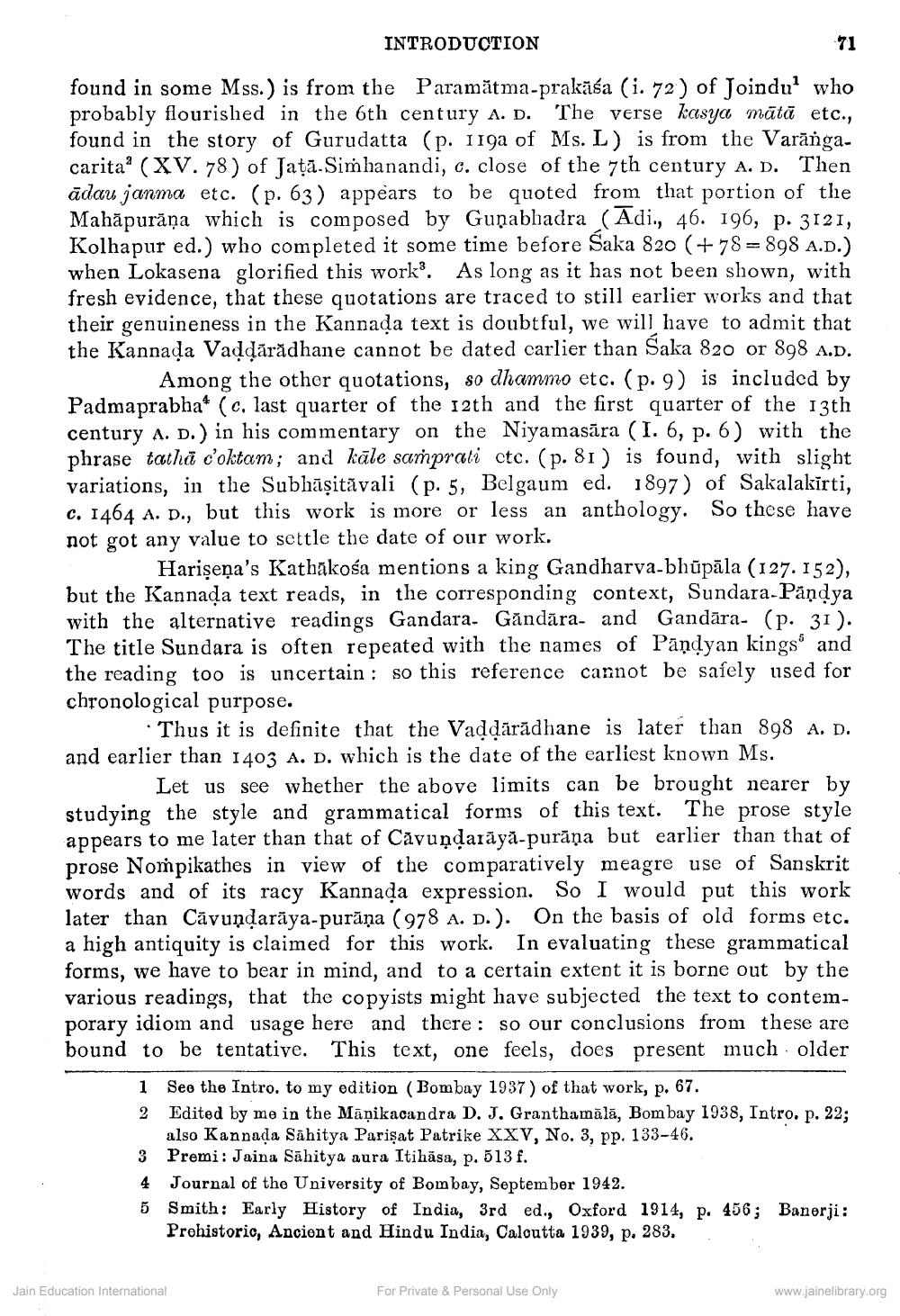________________
INTRODUCTION
found in some Mss.) is from the Paramātma-prakāśa (i. 72 ) of Joindu' who probably flourished in the 6th century A. D. The verse kasya mātā etc., found in the story of Gurudatta (p. 119a of Ms. L) is from the Varāngacarita' (XV. 78) of Jațā. Simhanandi, c. close of the 7th century A. D. Then ādau janma etc. (p. 63) appears to be quoted from that portion of the Mahāpurāņa which is composed by Gunabhadra (Adi., 46. 196, p. 3121, Kolhapur ed.) who completed it some time before Saka 820 (+ 78 - 898 A.D.) when Lokasena glorified this work. As long as it has not been shown, with fresh evidence, that these quotations are traced to still earlier works and that their genuineness in the Kannada text is doubtful, we will have to admit that the Kannada Vadạārădhane cannot be dated carlier than Saka 820 or 898 A.D.
Among the other quotations, so dhammo etc. (p. 9) is included by Padmaprabha* (c, last quarter of the 12th and the first quarter of the 13th century A. D.) in his commentary on the Niyamasāra (I. 6, p. 6) with the phrase tathä с'oktam; and kāle samprati ctc. (p. 81) is found, with slight variations, in the Subhāṣitāvali (p. 5, Belgaum ed. 1897) of Sakalakirti, c. 1464 A. D., but this work is more or less an anthology. So these have not got any value to settle the date of our work.
Harisena's Kathākosa mentions a king Gandharva-bhūpāla (127. 152), but the Kannada text reads, in the corresponding context, Sundara-Pāņdya with the alternative readings Gandara. Gåndāra- and Gandara- (p. 31). The title Sundara is often repeated with the names of Pandyan kings and the reading too is uncertain : so this reference cannot be safely used for chronological purpose.
Thus it is definite that the Vaddārādhane is later than 898 A. D. and earlier than 1403 A. D. which is the date of the earliest known Ms.
Let us see whether the above limits can be brought nearer by studying the style and grammatical forms of this text. The prose style appears to me later than that of Cavundarāyå-purāņa but earlier than that of prose Nompikathes in view of the comparatively meagre use of Sanskrit words and of its racy Kannada expression. So I would put this work later than Cāvuņdarāya-purāņa (978 A. D.). On the basis of old forms etc. a high antiquity is claimed for this work. In evaluating these grammatical forms, we have to bear in mind, and to a certain extent it is borne out by the various readings, that the copyists might have subjected the text to contemporary idiom and usage here and there : so our conclusions from these are bound to be tentative. This text, one feels, does present much older
1 See the Intro. to my edition (Bombay 1937) of that work, p. 67. 2 Edited by me in the Māņikacandra D. J. Granthamālā, Bombay 1938, Intro. p. 22;
also Kannada Sāhitya Parişat Patrike XXV, No. 3, pp. 133-46. 3 Premi: Jaina Sahitya aura Itihäsa, p. 513 f. 4 Journal of the University of Bombay, September 1942. 5 Smith: Early History of India, 3rd ed., Oxford 1914, p. 456; Banerji:
Prehistoric, Ancient and Hindu India, Caloutta 1939, p. 283.
Jain Education International
For Private & Personal Use Only
www.jainelibrary.org




